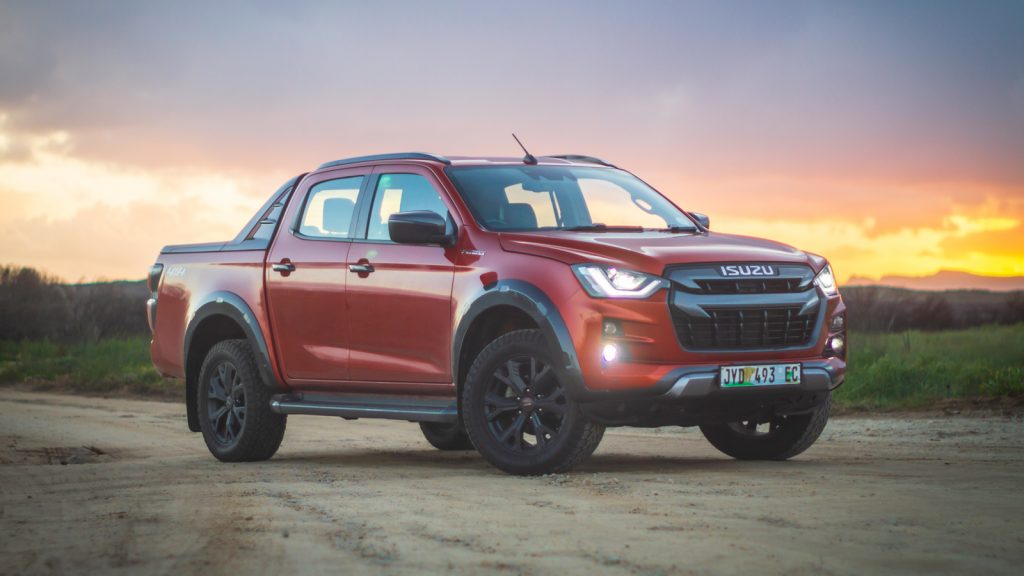V-Cross means something special to Isuzu fans. But how does it work in the South African context? We test Isuzu’s most luxurious double-cab bakkie.
Bakkies. South Africans love them. We buy bakkies in a proportionally higher volume than most markets. Why? Because we love exploring the outdoors and have fairly enabling year-round weather for adventure travel.
No ad to show here.
But it’s also because we have rapidly degrading road infrastructure, and a bakkie, with its larger tyres and robust suspension, is more likely to survive a pothole strike at speed, than a crossover. Or any other configuration of conventional passenger car.
The double cab bakkie has become South Africa’s default family vehicle of choice. And in the competitively traded bakkie market, Isuzu has terrific legacy. And it only does bakkies, with the brand’s focus undiluted by passenger cars.
A bakkie with presence
If you want to embrace peak Isuzu, that will be the D-Max V-Cross 3.0 TD auto 4×4.
The orange paint finish might be a bit OTT for some, but the overall D-Max shape and proportions are designed to appeal to a broad spectrum of bakkie drivers. And with daytime running LEDs and some cosmetically distinguishing trim, the V-Cross has that image appeal which is crucial to lifestyle bakkie buyers in the price range between R800 000 and R1m.
One of the most significant challenges for bakkie designers is UX. Bakkie drivers want as much device integration and screen mirroring as any urbanite in their city car, but the way bakkies drive makes that challenging.
The issue with bakkies and touchscreens
So, what can be so tricky about bakkie UX? It’s the fact that when a bakkie isn’t loaded, it rides quite harshly. Bakkies are designed to carry weight on the rear axle, but they hardly ever do when used as a family vehicle.
‘What does it matter is a bakkies rides a bit harshly when unladen’? Have you ever tried to use a touchscreen device while driving on a gravel road? It’s nearly impossible to master the touch haptics with a harsh road surface and rudimentary suspension, bouncing you about in your seat.
To prevent frustration in touchscreen integration, bakkie designers have used a hybrid UX approach: screen haptics supported by physical tabs, dials, and buttons. And it just works. Isuzu has been wise to retain some of the D-Max’s infotainment and HVAC functions via physical touchpoints instead of defaulting the entire UX design to touchscreen interfacing.
The 9-inch screen doesn’t have great iconography or graphics, with very average resolution.
V-Cross is made for Karoo roads
There is a legacy of localised engineering to configure Isuzu bakkies for South African roads. It helps that they are built here, too. That suspension fine-tuning makes a difference. The D-Max welcomes long dirt road detours. The more corrugated, the better.
Isuzu’s 3-litre turbodiesel engine isn’t the most powerful in-class, rated 140kW and 450Nm. Its six-speed automatic transmission lacks the flexibility and intuition, of Ford’s ten-speed, in the latest Ranger. But the overall powertrain experience won’t be an issue for legacy Isuzu fans, especially those who haven’t experienced the V6 turbodiesel engines in rival double-cabs.
The V-cross rolls sensible off-road specification tyres instead of oversized wheels with low-profile tyres – which is often a specification mistake with luxury double-cab bakkies, in the local market. Those large-volume tyres absorb much of the surface texture when driving on severely corrugated dirt road. That contrasts with the halo bakkies from some other brands, which inch-up the wheel size and reduce the tyre sidewall, greatly degrading ride comfort. Foolishly.
Wonderfully confident rolling along dirt roads, the V-Cross version of Isuzu’s D-Max does most of the traditional bakkie things splendidly well. Like crushing long dirt road journeys with confidence. But there are some issues with the way it integrated advanced technology.
Collision avoidance hardware and software are valuable and valid on any contemporary vehicle. But in the South African market, with its often chaotic driving conditions and unusual road infrastructure scenarios, some of the most advanced systems can become annoying. It overreacts to issues that don’t exist in Europe, like pedestrians and animals routinely being in the road.
It tries too hard – at times
Isuzu’s Intelligent Driver Assistance System (IDAS), features a stereo camera integrated into the windshield, which scans the driving environment for vehicles, pedestrians, bicycles, obstacles and lane markings. And the latter triggers some peculiar interventions from the system. When rolling through roadworks, the IDAS system will try to keep you in-lane with a steering intervention. Even if it is obvious that you need to drive on a solid line, or at least cross it, to get through the roadworks.
There should be a simple steering wheel button to select a lower invention threshold for the IDAS, but there isn’t. Logically. Which is disappointing. Ford’s Ranger offers a very sophisticated driver and safety assistance system, which does feature a satellite button on the steering wheel to disable it, when you are confronted with unusual road conditions or traffic scenarios – like pedestrians walking next to the road.
Beyond the hyperactive IDAS, the D-Max range also features a curiously undersized and oddly angled footrest. Most double-cab bakkies, especially those with luxury cabin trim, are purchased with an automatic transmission, and Isuzu should offer a more ergonomic footrest.
Isuzu’s appeal
It might not have the most powerful engine, best ground clearance, quietest cabin or most advanced device interfacing, but somehow the D-Max endures. And that’s been the theme for Isuzu bakkies, for decades.
These bakkies never feature class-defining numbers, but their durability makes them so valuable as an ownership experience.
Desire a luxury double-cab bakkie, with some posing value and terrific dirt road cruising ability? D-Max V-Cross 3.0 TD auto 4×4 is exactly that. The D-Max V-Cross 3.0 TD auto 4×4 is priced at R857 700.
